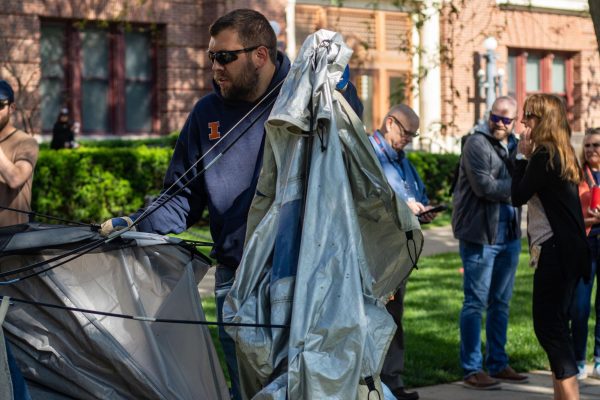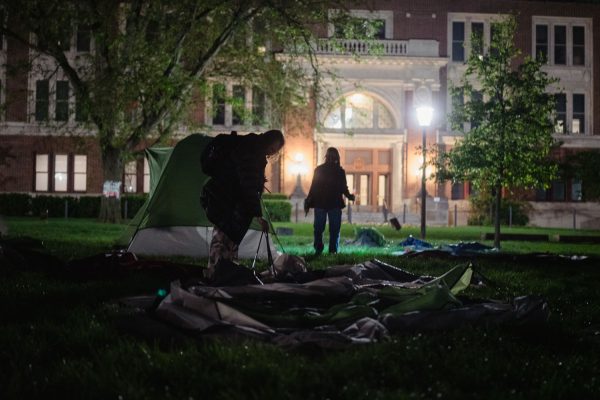Tennis players taking pass on college to go pro
January 18, 2005
Editor’s note: This is the first piece of a three-part series discussing the pattern of younger athletes choosing a professional career over college.
Illinois freshman Monte Tucker grew up playing tennis against Scoville Jenkins. But it is unlikely the two will compete against each other regularly in the near future.
Jenkins, 18, decided to forgo college to play tennis professionally.
He is not alone.
Jenkins is just one in a group of young American tennis players choosing to exchange their college eligibility for dreams of professional glory – and that number is growing.
Get The Daily Illini in your inbox!
The choice, said Illinois head coach Craig Tiley, is often made with too little foresight.
“There are some players where there is some value (in turning pro immediately),” Tiley said. “On the other hand there are some players where a transition year or two – or three or four – would be extremely beneficial to their lives.”
Tiley said the increase in American juniors turning pro instead of going to college has come quickly.
Three or four years ago, few juniors – except the very best – considered turning pro immediately. Now it has become the norm.
“What is new is that the very best are doing it for sure – it doesn’t even seem to be an issue that that is what their plan is,” said Michigan head coach Bruce Berque. “And it seems like a lot of guys beyond the very best are starting to have that thought in their mind.”
The dramatic increase in the number of juniors opting to turn pro immediately has come as Andy Roddick, Mardy Fish, Taylor Dent and Robby Ginepri have earned top spots in the professional rankings. Roddick skyrocketed through the rankings and finished No. 1 in the world in 2003. The others finished in the top 40 in 2003. None of the men went to college – and many talented up-and-coming juniors, who college coaches try to recruit every year, quickly determine that college might not be the best option if they want to become great professional athletes, Berque said. What those juniors may not realize is there were other athletes who turned pro without going to college and were not as successful.
“They have no reason to know who those guys are,” Berque said.
Some young athletes feel pressured to turn pro early to increase their chances of success. Tennis is demanding and careers can be short. Top singles players are typically younger and have more powerful, aggressive games. Doubles players tend to have slightly longer careers because doubles requires more specific skill, which takes time to develop.
However, the number of phenoms like Roddick who can quickly ascend to the top of the world rankings without going to college is limited, Tiley said.
“In tennis there has been a general attitude that if you don’t turn pro early then you’re not going to make it, but so few people make it anyway,” Tiley said. “You have a better chance of winning the lottery as far as being at that (highest) level.”
But the list of young Americans turning pro instead of going to college is growing.
Brendan Evans, who won the doubles title at the 2004 U.S. Open juniors tournament, was 15 when he signed a five-year $1.25 million deal with Nike. Alex Kuznetsov, 17, swept the Easter Bowl singles and doubles titles in 2003. He began his first full year as a professional this month. Fifteen-year-old Donald Young has jumped to the professional ranks too. He was the youngest player to win the boys’ 18-and-under Easter Bowl singles title last year. Brian Baker, who won the doubles title at the Northwestern Mutual/Wright Financial Group United States Tennis Association (USTA) Challenger in November, skipped college too.
American juniors, however, are not alone in their decision to turn pro at young ages. Dean Goldfine, a former USTA High Performance coach, said the “rest of the world has forced our hand.”
When Americans dominated professional tennis, nearly everyone went to college. If athletes won the NCAA title or had a spectacular year, then they turned pro. Otherwise athletes stayed in college for four years. Now, Goldfine said, many tennis players worldwide are competing in professional events at age 15 or 16. By the time they reach their late teen years, they are full-time pros.
Rafael Nadal, 18, defeated Roddick to help Spain win the Davis Cup title over the United States, in Seville, Spain, in December. Nadal turned pro in 2001. France’s Gael Monfils, who finished as the No. 1 player in the International Tennis Federation junior rankings in 2004, turned pro that year. Andrew Murray, 17, won the singles title at the U.S. Open juniors tournament last year and is already being heralded as Great Britain’s next big star.
“For our guys to keep up with (international athletes), they feel like they’ve got to do the same thing,” Goldfine said. “And unfortunately, that jeopardizes their development.”
But for the athletes whose careers – and lives – will be changed forever by their decision, there is no cookie-cutter answer to determine when they should start their professional careers, said former Georgia All-American Travis Parrott, who won the NCAA doubles title in 2001.
“If you’re ready, and it’s something that you want to do, then go for it,” Parrott said. “The belief has to come before the results. You have to believe that you are good enough to be out there with the top guys in the world before you can start beating them.”






